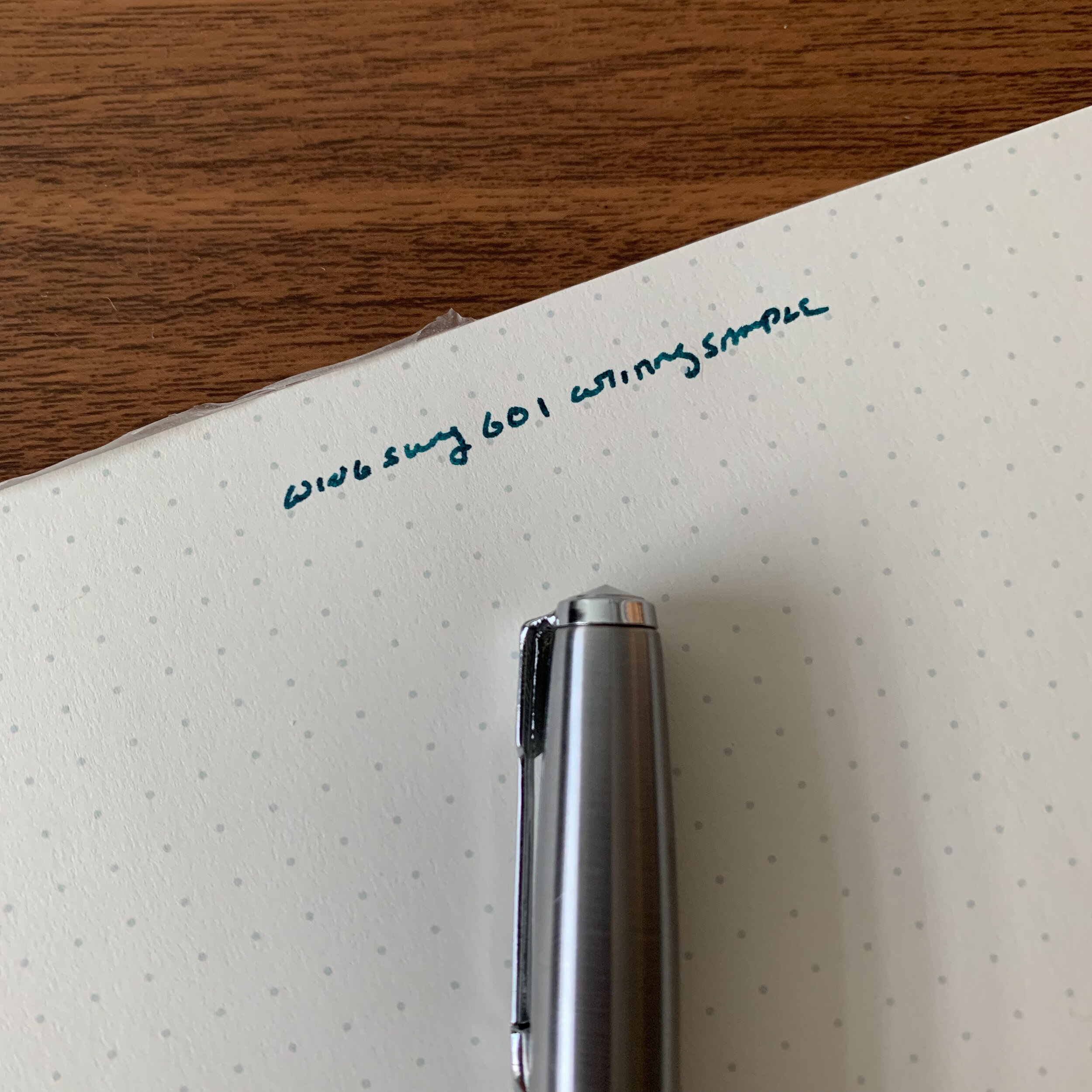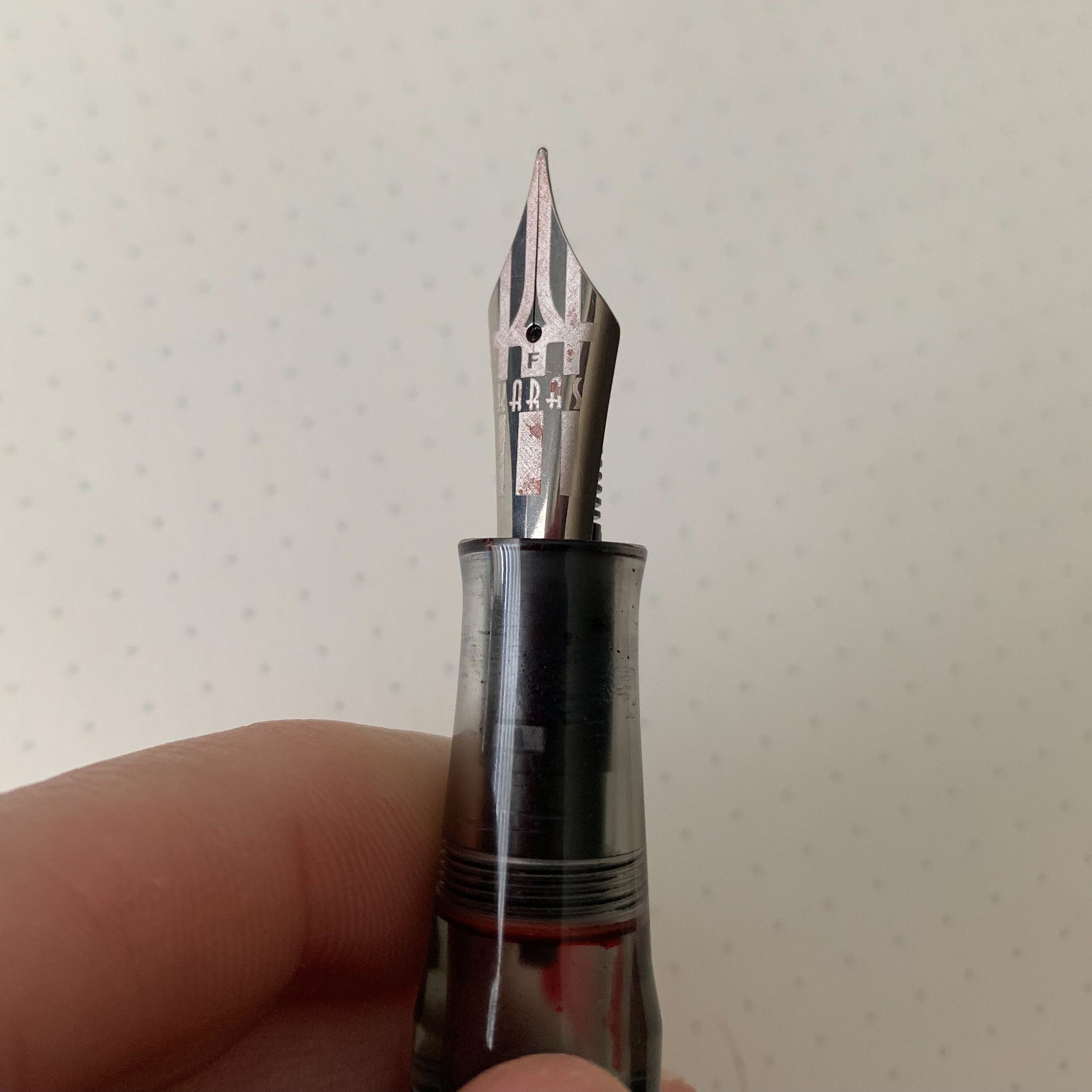Although Franklin-Christoph pens rotate through my pen case regularly, and I’ve been a customer of the company for years, their pens have not appeared on the blog as frequently as I would have liked. That changes now. Today I want to talk about my favorite Franklin-Christoph fountain pen: the Model 20 “Marietta.”
I tend to pick one or two models within a brand and stick with them as my daily users. There’s an easy explanation for this: Once I find a pen that fits my hand and meets my needs as an everyday writer, there’s not much incentive to go looking elsewhere. With Leonardo, of course there’s the Momento Zero. With Lamy, I prefer the Lamy 2000 and Lamy Studio and rarely use much else. With Montblanc, it’s the 146. Parker, the Sonnet, another great “unsung hero.” For Franklin-Christoph, it’s the Model 20.
The top of each cap is engraved with the understated Franklin-Christoph logo.
Inspired by vintage flat-top pens from the fountain pen “golden age” of the 1920s and 1930s, the Model 20 is a mid-sized pen notable for its friction-fit slip cap, and ability to easily convert from a cartridge-converter filling system to an eyedropper. I love the fact that this lightweight pen posts deeply, without adding much weight or length to the barrel. Though some might find the design too understated, or a bit plain, I regard it as an example of classic vintage-inspired penmaking, where the purpose of the pen is not just to create an objet d’art but rather to focus on the pen as a tool for writing.
My Winter Pine Model 20 posted. The cap on the Model 20 posts securely, and I’ve never had issues with it coming loose posted or capped.
One thing I appreciate about Franklin-Christoph is that they share a lot of information about their pen design on the website, which is always helpful for answering questions people may have about the various models. On the Model 20, I frequently get questions about the slip cap - namely “How does it stay on?” and “Won’t the cap develop cracks around the lip, like so many vintage slip cap pens do?” Well, I can’t vouch for how this pen will hold up 100 years from now, but I can say two things:
I’ve never had a Franklin-Christoph pen lose the cap in a pen case. F-C goes so far to say on their website: “When capped or posted properly it is impossible to sling the cap off, so [it] can be securely used in a shirt pocket or pen pouch.” Strong words, and they hold up.
I’ve never had a Model 20 crack, and in the unlikely event it did, (1) it would most likely be my fault because I did something stupid; and (2) Franklin-Christoph would fix it.
Though I don’t use this pen unposted, the Model 20 is still a comfortable length.
Another thing to note is that the design of the Model 20 has been refined and optimized to solve a problem that seems to plague slip-cap pens: ink being drawn into the cap by the vacuum that occurs when the pen is uncapped, particularly when the pen is eyedroppered. (See my recent review of the Karas Kustoms Vertex.) Franklin-Christoph notes that “[t]he interior of the cap has a feature that releases air pressure to eliminate the vacuum,” which I assume is a machining trade secret. Anyway, it works. I’ve not had any issues with Model 20 fountain pens leaking into the cap, even when I (rarely) eyedropper them.
“Maya Blue” might be my favorite color in the standard Franklin-Christoph lineup. Note the smooth section, free of any threads to interfere with your grip comfort. A key benefit of a slip-cap pen.
Franklin-Christoph Nibs
I should probably write a stand-alone article about Franklin-Christoph nibs, and I go back and forth on whether they are better known for their nibs than their pens at this point. All Franklin-Christoph pens accept either No. 5 or No. 6 JoWo nibs, are available in steel or gold, with standard nib widths or specialty grinds, and are tuned in-house prior to shipping. If you visit Franklin-Christoph at a pen show, they will tune the pen for you in person, and you will have the opportunity to sit at the table and provide live feedback as the nib is adjusted to your personal preference. I’ve never received a bad nib on a Franklin-Christoph pen.
A 14kt Franklin-Christoph JoWo No. 6 with a Masuyama Fine Cursive Italic.
Specialty grinds include the S.I.G. (Stub Italic Gradient), a stainless steel nib ground to a cross between a stub and a cursive italic, which offers the line variation of the latter with the smoother writing experience of the former. Audrey Matteson has taken over primary S.I.G. duties from the late Jim Rouse, who developed the grind, and under her stewardship the S.I.G. has become my preferred Franklin-Christoph nib. Other options include a “Fine Flex,” a 1.9mm Music Nib, as well as needlepoint, cursive italic, and stub grinds by Mike Masuyama.
On my Model 20 in “Winter Pine” that I acquired at this year’s D.C. Pen Show, I opted for a medium S.I.G. in the “Shadow” nib. It looks great and Audrey did an exceptional job tuning. This pen has the potential to become a favorite!
Takeaways and Where to Buy
I guess you could say that I have the beginning of a “mini-collection” of Franklin-Christoph Model 20s, with a high likelihood of picking up more in the future. The F-C table is one of my first stops in the morning at most pen shows, because the prototypes go fast!
Franklin-Christoph only sells their standard line direct to customers on their website. Currently, the Model 20 is available in Classic Black, Diamondcast Green, Vintage Green (pictured here), Maya Blue (pictured here), and Tiger Red. An excellent reason to visit a pen show is to have the opportunity to pick up Franklin-Christoph pens in various “prototype” materials, like the “Winter Pine” Model 20 that I purchased at the 2019 D.C. Pen Show. Occasionally, you can find special runs of unique materials in The Stock Room section of the F-C website. All Model 20 pens are priced at $165 for a standard steel-nib pen, with additional charges for specialty or gold nibs.
If you are looking for a smaller pen, consider the “Pocket 20” (currently listed as the “Model 20p”), which is priced at $145 but takes the same No. 6 JoWo nib. Back in 2015, I reviewed the Pocket 66 and Model 65 Stabilis Eyedroppers. While those two pens did not work for me over the long-term, and I’ve gone all-in on the Model 20, they are also great options and you may find the review of interest.
Franklin-Christoph also offers more than just pens, having recently expanded into watches, bags, and other luxury accessories. I’ve previously reviewed their leather Covered Pen Tray, and plan to review their “Penvelope” series of cases in the near future. Let’s just say I’m following their Initial Watch Offering closely….
Disclaimer: I purchased the pens featured in this review with my own funds, for my own personal use.








